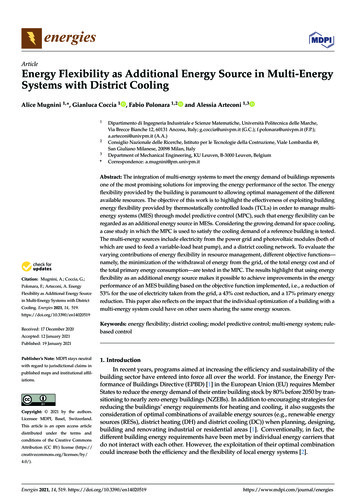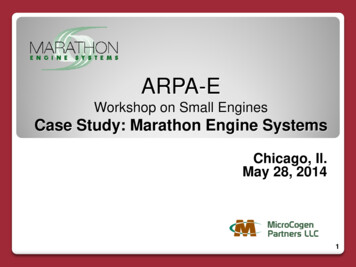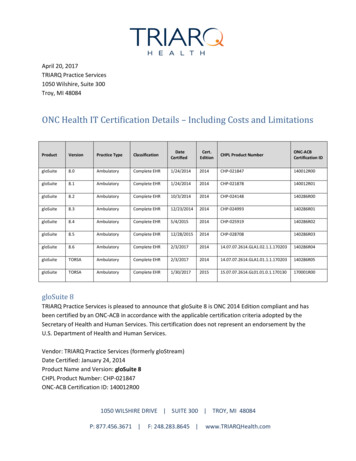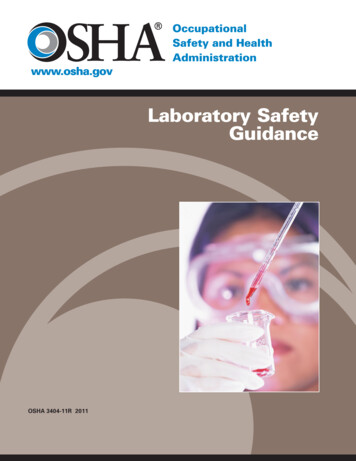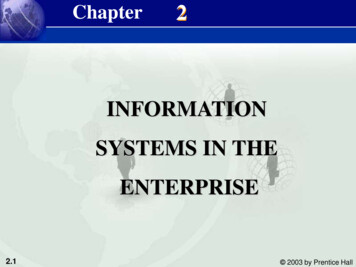
Transcription
Chapter2INFORMATIONSYSTEMS IN THEENTERPRISE2.1 2003 by Prentice Hall
Essentials of Management Information SystemsChapter 2 Information Systems in the EnterpriseOBJECTIVES What are the key system applications in abusiness? What role do they play? How do information systems support themajor business functions? Why should managers pay attention tobusiness processes?2.2 2003 by Prentice Hall
Essentials of Management Information SystemsChapter 2 Information Systems in the EnterpriseOBJECTIVES What are the business benefits of usingcollaborative commerce, privateindustrial networks and enterprisesystems? What types of information systems areused by companies that operateinternationally?2.3 2003 by Prentice Hall
Essentials of Management Information SystemsChapter 2 Information Systems in the EnterpriseMANAGEMENT CHALLENGES1. Integration: Different systems servevariety of functions, connectingorganizational levels difficult, costly2. Enlarging scope of managementthinking: Huge system investments,long development time must be guidedby common objectives2.4 2003 by Prentice Hall
Essentials of Management Information SystemsChapter 2 Information Systems in the EnterpriseKEY SYSTEM APPLICATIONS IN THE ORGANIZATIONTypes of Information Systems2.5Figure 2-1 2003 by Prentice Hall
Essentials of Management Information SystemsChapter 2 Information Systems in the EnterpriseKEY SYSTEM APPLICATIONS IN THE ORGANIZATIONMajor Types of Systems Executive Support Systems (ESS) Decision Support Systems (DSS) Management Information Systems (MIS) Knowledge Work Systems (KWS) Office Automation Systems (OAS) Transaction Processing Systems (TPS)2.6 2003 by Prentice Hall
Essentials of Management Information SystemsChapter 2 Information Systems in the EnterpriseTYPES OF INFORMATION SYSTEMS2.7Figure 2-2 2003 by Prentice Hall
Essentials of Management Information SystemsChapter 2 Information Systems in the EnterpriseKEY SYSTEM APPLICATIONS IN THE ORGANIZATIONTransaction Processing Systems (TPS): Basic business systems that serve theoperational level A computerized system that performs andrecords the daily routine transactionsnecessary to the conduct of the business2.8 2003 by Prentice Hall
Essentials of Management Information SystemsChapter 2 Information Systems in the EnterpriseKEY SYSTEM APPLICATIONS IN THE ORGANIZATIONPayroll TPSFigure 2-32.9 2003 by Prentice Hall
Essentials of Management Information SystemsChapter 2 Information Systems in the EnterpriseKEY SYSTEM APPLICATIONS IN THE ORGANIZATIONTypes of TPS SystemsFigure 2-42.10 2003 by Prentice Hall
Essentials of Management Information SystemsChapter 2 Information Systems in the EnterpriseKEY SYSTEM APPLICATIONS IN THE ORGANIZATIONKnowledge Work Systems (KWS):Knowledge level Inputs: Design specs Processing: Modeling Outputs: Designs, graphics Users: Technical staffExample: Engineering work station2.11 2003 by Prentice Hall
Essentials of Management Information SystemsChapter 2 Information Systems in the EnterpriseKEY SYSTEM APPLICATIONS IN THE ORGANIZATIONManagement Information System (MIS):Management level Inputs: High volume data Processing: Simple models Outputs: Summary reports Users: Middle managersExample: Annual budgeting2.12 2003 by Prentice Hall
Essentials of Management Information SystemsChapter 2 Information Systems in the EnterpriseKEY SYSTEM APPLICATIONS IN THE ORGANIZATIONManagement Information System (MIS)Figure 2-52.13 2003 by Prentice Hall
Essentials of Management Information SystemsChapter 2 Information Systems in the EnterpriseKEY SYSTEM APPLICATIONS IN THE ORGANIZATIONManagement Information System (MIS) Structured and semi-structured decisions Report control oriented Past and present data Internal orientation Lengthy design process2.14 2003 by Prentice Hall
Essentials of Management Information SystemsChapter 2 Information Systems in the EnterpriseKEY SYSTEM APPLICATIONS IN THE ORGANIZATIONDecision Support System (DSS):Management level Inputs: Low volume data Processing: Interactive Outputs: Decision analysis Users: Professionals, staffExample: Contract cost analysis2.15 2003 by Prentice Hall
Essentials of Management Information SystemsChapter 2 Information Systems in the EnterpriseKEY SYSTEM APPLICATIONS IN THE ORGANIZATIONDecision Support System (DSS)2.16Figure 2-6 2003 by Prentice Hall
Essentials of Management Information SystemsChapter 2 Information Systems in the EnterpriseKEY SYSTEM APPLICATIONS IN THE ORGANIZATIONDecision Support System (DSS)Figure 2-72.17 2003 by Prentice Hall
Essentials of Management Information SystemsChapter 2 Information Systems in the EnterpriseKEY SYSTEM APPLICATIONS IN THE ORGANIZATIONExecutive Support System (ESS):Strategic level Inputs: Aggregate data Processing: Interactive Outputs: Projections Users: Senior managersExample: 5-year operating plan2.18 2003 by Prentice Hall
Essentials of Management Information SystemsChapter 2 Information Systems in the EnterpriseKEY SYSTEM APPLICATIONS IN THE ORGANIZATIONExecutive Support System (ESS)2.19Figure 2-8 2003 by Prentice Hall
Essentials of Management Information SystemsChapter 2 Information Systems in the EnterpriseKEY SYSTEM APPLICATIONS IN THE ORGANIZATIONExecutive support system (ESS) Top level management Designed to the individual Ties CEO to all levels Very expensive to keep up Extensive support staff2.20 2003 by Prentice Hall
Essentials of Management Information SystemsChapter 2 Information Systems in the EnterpriseINTERRELATIONSHIPS AMONG SYSTEMS2.21Figure 2-9 2003 by Prentice Hall
Essentials of Management Information SystemsChapter 2 Information Systems in the EnterpriseSYSTEMS FROM A FUNCTIONAL PERSPECTIVESales and Marketing SystemsMajor functions of systems: Sales management, market research,promotion, pricing, new productsMajor application systems: Sales order info system, market researchsystem, pricing system2.22 2003 by Prentice Hall
Essentials of Management Information SystemsChapter 2 Information Systems in the EnterpriseSYSTEMS FROM A FUNCTIONAL PERSPECTIVESales and Marketing SystemsSYSTEMDESCRIPTIONORDER PROCESSING ENTER, PROCESS, TRACK ORDERSORGANIZATIONAL LEVELOPERATIONALMARKET ANALYSISIDENTIFY CUSTOMERS & MARKETS KNOWLEDGEPRICING ANALYSISDETERMINE PRICESMANAGEMENTSALES TRENDSPREPARE 5-YEAR FORECASTSSTRATEGIC2.23 2003 by Prentice Hall
Essentials of Management Information SystemsChapter 2 Information Systems in the EnterpriseSYSTEMS FROM A FUNCTIONAL PERSPECTIVEManufacturing and Production SystemsMajor functions of systems: Scheduling, purchasing, shipping,receiving, engineering, operationsMajor application systems: Materials resource planning systems,purchase order control systems,engineering systems, quality controlsystems2.24 2003 by Prentice Hall
Essentials of Management Information SystemsChapter 2 Information Systems in the EnterpriseSYSTEMS FROM A FUNCTIONAL PERSPECTIVEManufacturing and Production SystemsSYSTEMMACHINE CONTROLDESCRIPTIONCONTROL ACTIONS OF EQUIPMENTORGANIZATIONAL LEVELOPERATIONALCOMPUTER-AIDED-DESIGN DESIGN NEW PRODUCTSKNOWLEDGEPRODUCTION PLANNINGDECIDE NUMBER, SCHEDULE OF PRODUCTSMANAGEMENTFACILITIES LOCATIONDECIDE WHERE TO LOCATE FACILITIESSTRATEGIC2.25 2003 by Prentice Hall
Essentials of Management Information SystemsChapter 2 Information Systems in the EnterpriseSYSTEMS FROM A FUNCTIONAL PERSPECTIVEOverview of Inventory SystemsFigure 2-102.26 2003 by Prentice Hall
Essentials of Management Information SystemsChapter 2 Information Systems in the EnterpriseSYSTEMS FROM A FUNCTIONAL PERSPECTIVEFinancing and Accounting SystemsMajor functions of systems: Budgeting, general ledger, billing, costaccountingMajor application systems: General ledger, accounts receivable,accounts payable, budgeting, fundsmanagement systems2.27 2003 by Prentice Hall
Essentials of Management Information SystemsChapter 2 Information Systems in the EnterpriseSYSTEMS FROM A FUNCTIONAL PERSPECTIVEFinancing and Accounting SystemsSYSTEMDESCRIPTIONORGANIZATIONAL LEVELACCOUNTS RECEIVABLE TRACK MONEY OWED TO FIRMOPERATIONALPORTFOLIO ANALYSISDESIGN FIRM'S INVESTMENTSKNOWLEDGEBUDGETINGPREPARE SHORT TERM BUDGETS MANAGEMENTPROFIT PLANNINGPLAN LONG-TERM PROFITS2.28STRATEGIC 2003 by Prentice Hall
Essentials of Management Information SystemsChapter 2 Information Systems in the EnterpriseSYSTEMS FROM A FUNCTIONAL PERSPECTIVEHuman Resource SystemsMajor functions of systems: Personnel records, benefits,compensation, labor relations, trainingMajor application systems: Payroll, employee records, benefitsystems, career path systems, personneltraining systems2.29 2003 by Prentice Hall
Essentials of Management Information SystemsChapter 2 Information Systems in the EnterpriseSYSTEMS FROM A FUNCTIONAL PERSPECTIVEHuman Resource SystemsSYSTEMDESCRIPTIONORGANIZATIONAL LEVELTRAINING & DEVELOPMENTTRACK TRAINING, SKILLS, APPRAISALSOPERATIONALCAREER PATHINGDESIGN EMPLOYEE CAREER PATHSKNOWLEDGECOMPENSATION ANALYSISMONITOR WAGES, SALARIES, BENEFITSMANAGEMENTHUMAN RESOURCES PLANNING PLAN LONG-TERM LABOR FORCE NEEDS2.30STRATEGIC 2003 by Prentice Hall
Essentials of Management Information SystemsChapter 2 Information Systems in the EnterpriseSYSTEMS FROM A FUNCTIONAL PERSPECTIVEHuman Resource SystemsFigure 2-112.31 2003 by Prentice Hall
Essentials of Management Information SystemsChapter 2 Information Systems in the EnterpriseINTEGRATING FUNCTIONS AND BUSINESS PROCESSESBusiness Processes and Information SystemsBusiness processes Manner in which work is organized,coordinated, and focused to produce avaluable product or service Concrete work flows of material,information, and knowledge—sets ofactivities2.32 2003 by Prentice Hall
Essentials of Management Information SystemsChapter 2 Information Systems in the EnterpriseINTEGRATING FUNCTIONS AND BUSINESS PROCESSESBusiness Processes and Information Systems Unique ways to coordinate work,information, and knowledge Ways in which management choosesto coordinate work2.33 2003 by Prentice Hall
Essentials of Management Information SystemsChapter 2 Information Systems in the EnterpriseINTEGRATING FUNCTIONS AND BUSINESS PROCESSESBusiness Processes and Information SystemsInformation systems help organizations Achieve great efficiencies by automatingparts of processes Rethink and streamline processes2.34 2003 by Prentice Hall
Essentials of Management Information SystemsChapter 2 Information Systems in the EnterpriseINTEGRATING FUNCTIONS AND BUSINESS PROCESSESExamples of Business Processes Manufacturing and production:Assembling product, checking quality,producing bills of materials Sales and marketing: Identifyingcustomers, creating customer awareness,selling2.35 2003 by Prentice Hall
Essentials of Management Information SystemsChapter 2 Information Systems in the EnterpriseINTEGRATING FUNCTIONS AND BUSINESS PROCESSESExamples of Business Processes Finance and accounting: Payingcreditors, creating financial statements,managing cash accounts Human Resources: Hiring employees,evaluating performance, enrollingemployees in benefits plans2.36 2003 by Prentice Hall
Essentials of Management Information SystemsChapter 2 Information Systems in the EnterpriseINTEGRATING FUNCTIONS AND BUSINESS PROCESSESBusiness Processes and Information SystemsCross-Functional Business Processes Transcend boundary between sales,marketing, manufacturing, and researchand development Group employees from different functionalspecialties to a complete piece of workExample: Order Fulfillment Process2.37 2003 by Prentice Hall
Essentials of Management Information SystemsChapter 2 Information Systems in the EnterpriseINTEGRATING FUNCTIONS AND BUSINESS PROCESSESThe Order Fulfillment ProcessFigure 2-122.38 2003 by Prentice Hall
Essentials of Management Information SystemsChapter 2 Information Systems in the EnterpriseINTEGRATING FUNCTIONS AND BUSINESS PROCESSESCustomer Relationship Management (CRM)Customer Relationship Management (CRM) Manages all ways used by firms to deal withexisting and potential new customers Business and Technology discipline Uses information system to coordinate entirebusiness processes of a firm2.39 2003 by Prentice Hall
Essentials of Management Information SystemsChapter 2 Information Systems in the EnterpriseINTEGRATING FUNCTIONS AND BUSINESS PROCESSESCustomer Relationship Management (CRM) Provides end-to-end customer care Provides a unified view of customeracross the company Consolidates customer data from multiplesources and provides analytical tools foranswering questions2.40 2003 by Prentice Hall
Essentials of Management Information SystemsChapter 2 Information Systems in the EnterpriseINTEGRATING FUNCTIONS AND BUSINESS PROCESSESCustomer Relationship Management (CRM)2.41Figure 2-13 2003 by Prentice Hall
Essentials of Management Information SystemsChapter 2 Information Systems in the EnterpriseINTEGRATING FUNCTIONS AND BUSINESS PROCESSESSupply Chain Management (SCM)Supply Chain Management (SCM) Close linkage and coordination ofactivities involved in buying, making, andmoving a product Integrates supplier, manufacturer,distributor, and customer logistics time Reduces time, redundant effort, andinventory costs2.42 2003 by Prentice Hall
Essentials of Management Information SystemsChapter 2 Information Systems in the EnterpriseINTEGRATING FUNCTIONS AND BUSINESS PROCESSESSupply Chain Management (SCM)Supply Chain Network of organizations and businessprocesses Helps in procurement of materials,transformation of raw materials intointermediate and finished products2.43 2003 by Prentice Hall
Essentials of Management Information SystemsChapter 2 Information Systems in the EnterpriseINTEGRATING FUNCTIONS AND BUSINESS PROCESSESSupply Chain Management (SCM) Helps in distribution of the finishedproducts to customers Includes reverse logistics - returned itemsflow in the reverse direction from thebuyer back to the seller2.44 2003 by Prentice Hall
Essentials of Management Information SystemsChapter 2 Information Systems in the EnterpriseINTEGRATING FUNCTIONS AND BUSINESS PROCESSESSupply Chain ManagementFigure 2-142.45 2003 by Prentice Hall
Essentials of Management Information SystemsChapter 2 Information Systems in the EnterpriseINTEGRATING FUNCTIONS AND BUSINESS PROCESSESHow Information Systems Facilitate Supply Chain Management 2.46Decide when, what to produce, store, moveRapidly communicate ordersCommunicate orders, track order statusCheck inventory availability, monitor levelsTrack shipmentsPlan production based on actual demandRapidly communicate product design changeProvide product specificationsShare information about defect rates, returns 2003 by Prentice Hall
Essentials of Management Information SystemsChapter 2 Information Systems in the EnterpriseINTEGRATING FUNCTIONS AND BUSINESS PROCESSESSupply Chain Management (SCM)Limitations: Inefficiencies can waste as much as 25%of company’s operating costs Bullwhip Effect: Information about thedemand for the product gets distorted asit passes from one entity to next2.47 2003 by Prentice Hall
Essentials of Management Information SystemsChapter 2 Information Systems in the EnterpriseINTEGRATING FUNCTIONS AND BUSINESS PROCESSESSupply Chain Management (SCM) Supply chain planning system: Enablesfirm to generate forecasts for a product andto develop sourcing and a manufacturingplan for the product Supply chain execution system:Manages flow of products throughdistribution centers and warehouses2.48 2003 by Prentice Hall
Essentials of Management Information SystemsChapter 2 Information Systems in the EnterpriseINTEGRATING FUNCTIONS AND BUSINESS PROCESSESCollaborative Commerce Uses digital technologies to enablemultiple organizations to collaborativelydesign, develop, build, move, and manageproducts Increases efficiencies in reducing productdesign life cycles, minimizing excessinventory, forecasting demand, andkeeping partners and customers informed2.49 2003 by Prentice Hall
Essentials of Management Information SystemsChapter 2 Information Systems in the EnterpriseINTEGRATING FUNCTIONS AND BUSINESS PROCESSESCollaborative CommerceFigure 2-152.50 2003 by Prentice Hall
Essentials of Management Information SystemsChapter 2 Information Systems in the EnterpriseINTEGRATING FUNCTIONS AND BUSINESS PROCESSESIndustrial NetworksPrivate Industrial Networks Web-enabled networks Link systems of multiple firms in anindustry Coordinate transorganizational businessprocesses2.51 2003 by Prentice Hall
Essentials of Management Information SystemsChapter 2 Information Systems in the EnterpriseINTEGRATING FUNCTIONS AND BUSINESS PROCESSESTraditional View of the Systems Within the business: There are functions,each having its uses of information systems Outside the organization’s boundaries:There are customers and vendorsFunctions tend to work in isolation2.52 2003 by Prentice Hall
Essentials of Management Information SystemsChapter 2 Information Systems in the EnterpriseINTEGRATING FUNCTIONS AND BUSINESS PROCESSESTraditional View of the SystemsFigure 2-162.53 2003 by Prentice Hall
Essentials of Management Information SystemsChapter 2 Information Systems in the EnterpriseINTEGRATING FUNCTIONS AND BUSINESS PROCESSESEnterprise Systems2.54Figure 2-17 2003 by Prentice Hall
Essentials of Management Information SystemsChapter 2 Information Systems in the EnterpriseINTEGRATING FUNCTIONS AND BUSINESS PROCESSESBenefits of Enterprise Systems Firm structure and organization: Oneorganization Management: Firm-wide knowledgebased management processes Technology: Unified platform Business: More efficient operations andcustomer-driven business processes2.55 2003 by Prentice Hall
Essentials of Management Information SystemsChapter 2 Information Systems in the EnterpriseINTEGRATING FUNCTIONS AND BUSINESS PROCESSESChallenges of Enterprise Systems Difficult to build: Require fundamentalchanges in the way the business operates Technology: Require complex pieces ofsoftware and large investments of time,money, and expertise Centralized organizationalcoordination and decision making:Not the best way for the firms to operate2.56 2003 by Prentice Hall
Essentials of Management Information SystemsChapter 2 Information Systems in the EnterpriseINTERNATIONAL INFORMATION SYSTEMSForms of Global Business OrganizationFour main ways of organizing businessesinternationally: Domestic Exporter: Heavy centralization ofcorporate activities in the home country oforigin Multinational: Financial management andcontrol out of a central home base,production, sales and marketing operationsdecentralized2.57 2003 by Prentice Hall
Essentials of Management Information SystemsChapter 2 Information Systems in the EnterpriseINTERNATIONAL INFORMATION SYSTEMSForms of Global Business Organization Franchiser: Product created, designed,financed, and produced in the home country,relies on foreign personnel for production,marketing and human resources Transnational: No national headquarters;value-added activities managed from a globalperspective, no reference to national borders,sources of supply and demand and localcompetitive advantage optimized2.58 2003 by Prentice Hall
Essentials of Management Information SystemsChapter 2 Information Systems in the EnterpriseINTERNATIONAL INFORMATION SYSTEMSGlobal System ConfigurationFour types of system configuration: Centralized Systems Duplicated Systems Decentralized Systems Networked Systems2.59 2003 by Prentice Hall
Essentials of Management Information SystemsChapter 2 Information Systems in the EnterpriseINTERNATIONAL INFORMATION SYSYTEMSGlobal System ConfigurationFigure 2-182.60 2003 by Prentice Hall
Chapter2INFORMATIONSYSTEMS IN THEENTERPRISE2.61 2003 by Prentice Hall
Essentials of Management Information Systems Chapter 2 Information Systems in the Enterprise SYSTEM DESCRIPTION ORGANIZATIONAL LEVEL TRAINING & DEVELOPMENT TRACK TRAINING, SKILLS, APPRAISALS OPERATIONAL CAREER PATHING DESIGN EMPLOY



